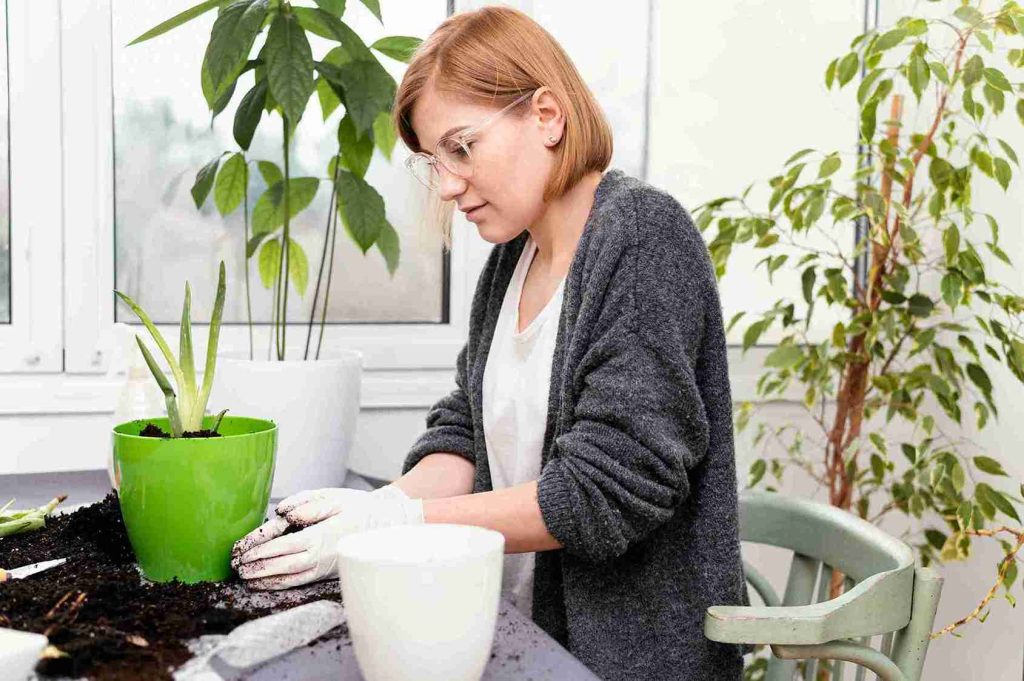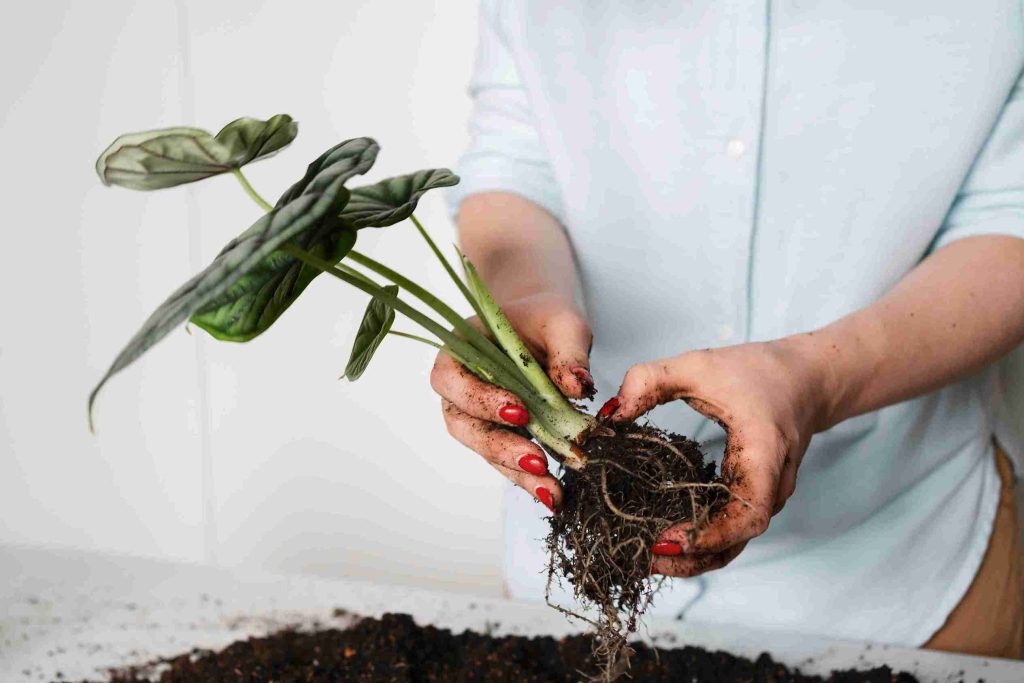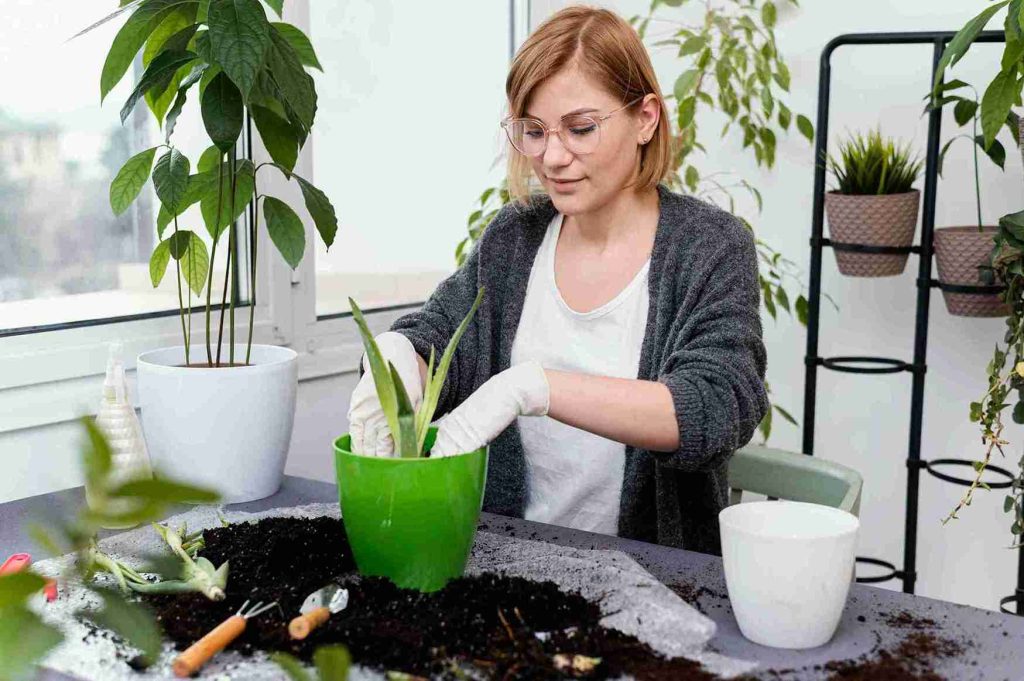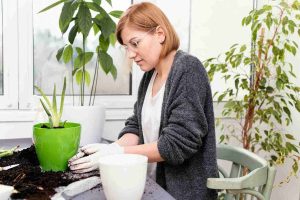I remember the first time I saw my plant looking sad, even though I had watered it and given it enough light. The leaves turned yellow, the growth stopped, and roots started poking out from the bottom. I had no idea what was wrong until I learned about the signs that your plant needs repotting.
At first, I didn’t think plants needed new pots unless they broke. But I was wrong. Over time, I saw how important repotting is. When a plant outgrows its pot, it doesn’t get enough space, water, or nutrients. That’s when it starts showing signs that it needs a change.
Now, I check my plants often. I look for root-bound pots, slow growth, and dry soil that drains too fast. If you’re new to plants, don’t worry. I’ll share simple ways to spot the repotting so you can help your green friend grow happy and healthy!

When Your Plant Needs Repotting
The first sign my plant gave me. A sad, droopy look was all it took. That moment started my journey to learn repotting. I had no idea how important pot size could be. I thought water and sun were enough. But space matters too. I learned to watch for signs, and this was my first. Here is the key point of learning when your plant needs repotting-
1. Roots Are Growing Out the Bottom
I once noticed roots coming out of the pot’s drainage holes. At first, I thought it was normal. But the plant looked sad and droopy. I checked online and learned this means it’s root-bound. That means the roots don’t have space to grow. I lifted the plant from its pot and saw twisted roots. They circled the bottom and had no room left.
The soil looked dry and hard. It didn’t hold water well anymore. I felt bad for the plant. I gently teased the roots apart and gave it a bigger pot. I added fresh soil and watered it well. In a few days, the plant looked happier. The leaves perked up and turned bright green. Now, I always check the bottom of the pot. If I see roots poking out, I know it’s time.
This was the first sign I learned. It’s very easy to miss. But once you know, it’s clear. Roots need room to grow strong and healthy. I learned that from my pothos plant. That day changed how I care for all my plants. Always check the bottom holes—your plant may be asking for help.
2. Water Runs Straight Through the Pot
One day, I watered my plant and noticed something odd. The water ran straight through and didn’t soak in. The soil stayed dry even after I watered it. I knew something was wrong. I took the plant out and saw dry, hard soil with thick roots. It had no space left to absorb water. The roots filled the pot and left little soil behind. This meant it was time to repot.
I added fresh, soft soil to a bigger pot. I gave the plant a nice drink of water. The soil soaked it up right away. The plant looked better within a week. I learned that when water runs through fast, it’s not a good sign. It means the roots are too packed, and the soil has gone bad. I used to think fast drainage was okay. But now I know better.
Water should stay in the soil for a little while. That way, the plant can drink slowly. If it runs right out, the plant gets thirsty. I watch every plant closely now when I water. If I see fast drainage, I check the roots. It’s one of the best signs that a plant needs repotting.
3. The Plant Looks Too Big for Its Pot
I once had a peace lily that kept falling over. It looked too big for its small pot. I thought maybe it needed water. But watering didn’t help. It still leaned to one side. One day, I tried to move it and felt the pot wobble. The plant had outgrown the pot.
Its base was wider than the container. I gently removed it and saw roots all around. It had no more room to grow. I got a pot that was two inches bigger. I added fresh soil and gave it a new home. In just a few days, the peace lily stood tall again. I realized that if a plant looks top-heavy, it probably needs repotting. I now check the balance of each plant.
If it tips over easily, I check the roots. A bigger plant needs a bigger space. It’s just like when kids grow out of shoes. A pot that’s too small can hurt the plant. It can’t get water or nutrients well. I’ve learned to notice when a plant is growing fast. That usually means it’ll need more room soon. A happy plant fits nicely in its pot, not squeezed in tight.
4. The Leaves Are Yellowing or Falling Off
One of my ferns started turning yellow last spring. I thought maybe I had overwatered it. I let it dry out, but the leaves still dropped. I checked for pests but saw none. That’s when I looked at the roots. I pulled the plant out and saw they were packed tight. The roots had no space to breathe or grow. They were wrapped around each other like spaghetti.
I realized the plant was root-bound and stressed. That’s why it was losing leaves. I repotted it into a slightly bigger pot. I added fresh soil and watered it gently. The plant stopped losing leaves, and new green ones grew soon after. I learned that yellowing or falling leaves aren’t always about water. Sometimes, it’s about space. When plants feel trapped, they show it in their leaves. Now, if I see lots of yellow or brown leaves, I check the roots too.
Not all leaf problems mean bugs or water issues. A tight space can be the hidden cause. My fern taught me that lesson. Giving your plant more space might fix what water can’t. Always check the roots when the leaves don’t look right.
5. The Soil Smells Bad or Looks Moldy
I once walked past my snake plant and smelled something weird. It wasn’t a strong smell, but it wasn’t nice either. I bent down and sniffed the soil. It smelled sour and moldy. That’s when I noticed white fuzz on the top layer. I knew that wasn’t normal. I dug a little into the soil and saw more mold inside.
The soil was soggy even though I hadn’t watered in days. I pulled the plant out and found its roots sitting in wet, sticky dirt. Some roots looked black and soft. I learned those were signs of root rot. I cleaned the roots and cut off the mushy parts. Then, I placed the plant in fresh, dry soil inside a new pot. The smell went away, and the plant perked up.
That day taught me to smell my soil often. Bad smells or mold are signs that something’s wrong. Old soil breaks down and doesn’t drain well. It can hurt the roots and trap too much water. If I smell something off, I check right away. Clean soil and a good pot make a big difference. Trust your nose—it can save your plant’s life.

How Do I Know When My Plant Needs Repotting?
I’ve learned that repotting is essential for plant health. When I notice my plant growing slowly, it’s a sign. If the roots are pushing out of the drainage holes, it’s time. The plant might also start wilting despite regular watering.
I check the soil by gently pulling the plant out of the pot. If the roots are tightly packed or circling, it’s definitely time. Sometimes, the soil looks dry, even after watering. That means it’s not absorbing water well anymore. Also, if the plant has outgrown the pot or becomes top-heavy, repotting is necessary. A plant that outgrows its pot may not get enough nutrients.
If my plant seems to be struggling despite my care, I repot it. I try to repot during the growing season for the best results. Repotting at the right time helps my plant grow healthier and thrive. So, I always keep an eye on its growth and soil conditions to know when it’s time.
How Often Should You Repot Houseplants?
I usually repot my houseplants every 1 to 2 years. Some plants grow quickly, so I repot them more often. I look at how fast they are growing. If they seem cramped in their pot, I repot them sooner. Plants like succulents don’t need repotting as often.
On the other hand, fast-growing plants, like ferns, need it more often. If the soil gets compacted, it’s a sign I need to repot. If roots start showing out of the bottom, it’s definitely time. I check for root rot, too. If the soil dries out too fast, my plant might need a new pot.
The best time to repot is in the spring or early summer. This gives plants time to adjust before the colder months. Keeping track of the plant’s growth and pot condition helps me decide when to repot. Repotting too often can stress the plant, so I always wait until necessary.
How to Choose the Right Pot Size for Repotting
I always pick a pot that’s 2 inches larger than the current one. This gives my plant enough room to grow without being overwhelmed. If I choose a pot that is too big, the soil can stay wet too long. This might lead to root rot. I also checked that the pot had proper drainage holes.
Without drainage, the plant can’t get rid of excess water. For larger plants, I use a pot that’s just big enough to fit the roots. A pot that’s too small limits root growth, so I avoid that. I prefer choosing a pot with a similar shape to the old one. This helps the plant stay stable as it adjusts. I also make sure the new pot matches the plant’s needs.
For example, succulents need shallow pots, while others need deeper ones. Ultimately, I focus on giving the plant a comfortable space to grow. The right-sized pot makes repotting successful and encourages healthy growth.
How to Fix Compacted Soil in Potted Plants
When I notice my plant struggling, I check the soil first. If it’s hard and dry, it’s likely compacted. To fix it, I gently remove the plant from the pot. I shake off the old soil around the roots. Then, I prepare fresh, well-draining soil. I add it to the pot, leaving enough space for the plant’s roots. I make sure the new soil is loose and airy.
For extremely compacted soil, I may need to break it apart using a tool. It’s important to avoid over-watering after this process. I carefully repot the plant, making sure the roots have room to grow. The new soil should help with drainage and allow better root expansion.
I check the moisture level regularly to ensure the soil stays healthy. Fixing compacted soil ensures my plant thrives and grows better. Healthy, well-drained soil keeps the roots oxygenated, helping my plant flourish.
What Happens If You Don’t Repot Plants?
I’ve learned that not repotting plants can lead to problems. When plants outgrow their pots, they become root-bound. This restricts their growth and nutrient intake. Eventually, the roots can’t absorb water or nutrients properly.
The plant might stop growing and start wilting. In some cases, it becomes more vulnerable to pests and diseases. I noticed that when I don’t repot, the plant becomes unhealthy over time. The soil might also get compacted, preventing good drainage. Without fresh soil, the plant can’t get the nutrients it needs.
Additionally, the roots may start rotting if the pot is too small. If I wait too long, repotting becomes more stressful for the plant. So, I’ve learned that regular repotting is crucial for plant health. It keeps them happy, hydrated, and nourished, promoting growth and vitality.
Common Mistakes When Repotting Plants
I’ve made a few mistakes when repotting my plants. One common mistake is choosing a pot that’s too large. This can cause the soil to retain too much water. It leads to root rot and other problems. I also used to damage the roots by pulling too hard.
Now, I gently loosen them before repotting. Another mistake I’ve made is not checking drainage holes. Without good drainage, the roots drown in excess water. I’ve also overwatered plants after repotting, thinking they needed more water. This often causes root rot or other issues. Sometimes, I used the wrong type of soil, which didn’t match the plant’s needs.
I now make sure to use fresh, appropriate soil for each plant. Lastly, I forgot to repot at the right time. Repotting during dormancy or colder months stressed the plants. Now, I repot in spring or early summer for the best results. Avoiding these mistakes helps my plants thrive and grow healthier.
If you’re looking to avoid these common pitfalls and repot your indoor plants without causing shock, check out our guide on How to Repot an Indoor Plant Without Causing Shock for expert tips and advice!
Conclusion
Recognizing the signs that your plant needs repotting is crucial for its health and growth. Look for indicators such as roots growing out of the drainage holes, soil depletion, and a decrease in water absorption.
If your plant is top-heavy or shows signs of nutrient deficiency, it may also be time for a new pot. By repotting your plant at the right time, you can ensure it receives the necessary space and nutrients to thrive.
Regular monitoring and timely repotting will help keep your plants happy and flourishing. This simple care can make a big difference.

FAQ
How to know when to repot a plant
Look for roots growing out of drainage holes. If the plant is top-heavy, it may need a larger pot.
Signs your houseplant needs repotting
Roots poking out of the pot or soil drying quickly are clear signs. Also, if the plant isn’t growing well, it might need more space.
When to repot indoor plants
Repot plants when they become root-bound or outgrow their current pot. Typically, once every 1-2 years is a good time.
Repotting tips for houseplants
Choose a pot 1-2 inches larger than the current one. Be gentle with the roots to avoid damage during repotting.
Best time to repot plants
Spring is the best time to repot plants. It’s when they start their active growing season.
Roots coming out of pot drainage holes.
When roots grow out of drainage holes, it’s time to repot. This shows the plant has outgrown its space.
Soil dries out too quickly in pots.
If the soil dries too fast, the roots need more space to grow. Repot the plant in a larger pot with fresh soil.
Yellowing leaves and repotting needs
Yellow leaves may mean the roots are overcrowded or stressed. Repotting into a bigger pot can help the plant thrive.
Stunted plant growth in pots
When growth slows down, the plant might be root-bound. Repot it to give the roots more room to spread.
Top-heavy plants falling over.
A top-heavy plant can be stabilized by repotting it into a bigger, heavier pot. This helps prevent it from falling over.
Repotting guide for beginners
Choose a slightly larger pot and use fresh, well-draining soil. Gently remove the plant and place it in the new pot.
How to repot a root-bound plant step-by-step
Carefully remove the plant, loosen the roots, and trim any damaged ones. Place the plant in a larger pot with fresh soil.
Benefits of repotting houseplants regularly
Repotting gives plants more room to grow and fresh soil to feed on. It helps prevent diseases and encourages healthy growth.
Repotting tropical houseplants for better growth
Repot tropical plants every 1-2 years to ensure they get enough nutrients. A larger pot helps them thrive with proper root space.


